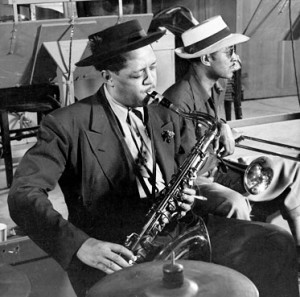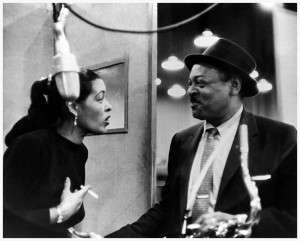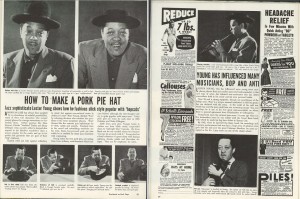photo credit, pbs.org, ken burns jazz series
 Lester Young (1909 – 1959)
Lester Young (1909 – 1959)
Photo credit, dailymusicbreak.com
By Deanne Savage
Before Pharrell Williams sported his hat to become the ultimate contemporary hip-cat; there was a group of young jazz musicians who transformed the jazz world with their playing and their sense of cool style – and the Hippest hep-cat of them all? Pork Pie hat, tipped to one side, thin necktie casually knotted, his saxophone dipped to his right? The incomparable, “Pres”, LESTER YOUNG.
photo credit, www.soulwalking.com
Lester Young is held up as one of the true jazz giants. His innovations changed the art form forever. A tenor saxophonist, Young followed his creative instinct and invented a completely different way in which to play his horn – helping to create an era known as “post-swing jazz” – floating over bar lines with a light tone rather than adopting Coleman Hawkins‘ then-dominant forceful approach. A non-conformist, Young (who was nicknamed “Pres” by Billie Holiday), is the creator of what is now known as the “Chicago Tenor Sound” and paving the way for Bebop Jazz. As we listen to the many saxophone players featured in Second Sunday at the Library, they will tell us, Lester Young has had an enormous influence on their playing.
Lester Young grew up in a highly musical family. The oldest of three children, he was born in the New Orleans area. By 1920, his family moved to Minneapolis. There, he performed in a legendary family band. He studied violin, trumpet, and drums, starting on alto at age 13. Because he refused to tour in the South, Young left home in 1927 and instead toured with Art Bronson’s Bostonians, and it was then, that he switched to tenor saxophone.
Young lived the hop around life, typical of many musicians attempting to make a living with their art. He was back with the family band in 1929 and then freelanced for a few years, playing with Walter Page’s Blue Devils (1930), Eddie Barefield in 1931, back with the Blue Devils during 1932-1933, and Bennie Moten and King Oliver (both 1933).
In 1934, he got into the Count Basie Band for the first time, but he left to replace Coleman Hawkins with Fletcher Henderson. Unfortunately, it was expected that Young would try to emulate Hawkins – and Young’s laid-back sound angered Henderson‘s sidemen, resulting in his not lasting long there.
After a tour with Andy Kirk and a few brief jobs, Lester Young was back with Basie in 1936; just in time to star with the band as they headed East. Young made history during his years with Basie, not only participating on Count‘s record dates but starring with Billie Holiday and Teddy Wilson on a series of classic small-group sessions. Extremely multi-talented, Young also performed in some rare recordings on clarinet with Basie and the Kansas City Six; a sound that is described as “very original”, “cool” and that “sounds that almost like altoist Paul Desmond in the 1950s.” Which makes me think, Paul Desmond was clearly influenced, by Young.
Young left The Count Basie Band in 1940, and his career became a bit capricious – not capitalizing on his fame in the jazz world. He ended up playing in Los Angeles in a low-profile band with his brother, drummer Lee Young, playing freelance in New York a bit and he also played in a U.S.O. Band. Then in December 1943, he went back to Count Basie. He stayed for nine months and recorded a memorable quartet session with bassist Slam Stewart, and starred in the short film Jammin’ the Blues. It was at this time, that Young and Basie finally began to get notoriety with the general public.
But, this was the World War II era, and like most young men, Lester Young was drafted. His experiences dealing with racism in the military were horrifying and he was completely cut off from his music. An experience he described as, “nightmarish”. This affected his mental state of mind for the remainder of his life. Some critics have written that Lester Young never sounded as good after getting out of the military, while others feel he actually hit his prime in the mid- to late-’40s. He toured (and was well paid by Norman Granz) with Jazz at the Philharmonic on and off through the ’40s and ’50s, made a wonderful series of recordings for Aladdin Records, and worked steadily as a solo player. Young also adopted his style well to bebop (which he had helped pave the way for in the 1930s).
However, Young suffered mentally and turned to alcohol; building a wall between himself and the outside world, and inventing his own colorful vocabulary. Although many of his recordings in the 1950s were excellent (showing a greater emotional depth than in his earlier days), Young was troubled by the fact that some of his white imitators were making much more money than he was.
1956’s Jazz Giants album found him in peak form as did a well documented engagement in Washington, D.C., with a quartet and a last reunion with Count Basie at the 1957 Newport Jazz Festival. But, for the 1957 telecast “The Sound of Jazz”, Young mostly played sitting down (although he stole the show with an emotional one-chorus blues solo played to Billie Holiday). After becoming ill in Paris in early 1959, Lester Young came home and essentially drank himself to death.
Many decades after his death, Pres is considered to be (along with Coleman Hawkins and John Coltrane) one of the three most important tenor saxophonists of all time.
NPR’s Murray Horwitz and jazz critic and poet AB Spellman recommend Lester Young’s The Complete Aladdin Recordings of Lester Young (Blue Note). Which we have at the Library in the Manieri CD Collection.
Also in the CD Collection:
- The “Kansas City Sessions”
- “Pres and Teddy”, Young with the Teddy Wilson Quartet
- “A Musical Romance”, Young and Billie Holliday
And many more:
http://library.cityofanacortes.org/client/en_US/default/search/results?qu=Lester+Young&te=&rt=false%7C%7C%7C511%7C%7C%7CPerformer
For a listing of all of his recorded albums, go to ARTISTdirect.com:
http://www.artistdirect.com/artist/lester-young/512681
Resources:
The Jazz Institute of Chicago – Article: “Lester Young; An American Original”, by David Simpson. Accessed on the world wide web on March 7, 2015.
http://www.jazzinchicago.org/educates/journal/articles/lester-young-american-original
PBS.com – Jazz a film by Ken Burns. Accessed on the world wide web on March 7, 2015.
http://www.pbs.org/jazz/biography/artist_id_young_lester.htm
Soul Walking, online music history resource, U.K. The Lester Young Page. Accessed on the world wide web, March 7, 2015
http://www.soulwalking.co.uk/Lester%20Young.html
ARTISTdirect, online music resource. Lester Young article/biography by Scott Yanow, Rovi. Accessed on the world wide web, March 7, 2015.
http://www.artistdirect.com/artist/bio/lester-young/512681


